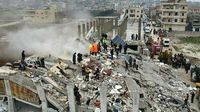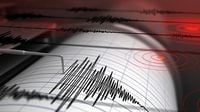On a quiet Sunday afternoon, as clocks struck 12:59 p.m. in Turkey’s western Kütahya province, the earth rumbled beneath the feet of thousands. A magnitude 5.4 earthquake struck the Simav district, sending tremors rippling through northwestern Turkey and as far as Istanbul, a city of over 15 million people some 100 kilometers to the north. The quake, which originated at a shallow depth of 8.46 kilometers (about 5 miles), startled residents and prompted many to rush out of their homes and workplaces, gathering in open squares and parks as a precaution, according to reports from Turkey’s Disaster and Emergency Management Authority (AFAD) and numerous international agencies including the Associated Press and Reuters.
Despite the dramatic shaking and the memories it stirred of past disasters, officials were quick to reassure the public. Kütahya Governor Musa Işın announced, “We wish everyone well. Our investigations and fieldwork continue. Thankfully, there have been no problems so far.” His words echoed across local news channels and social media, underscoring that, as of the latest reports, there had been no casualties or significant property damage. Simav’s mayor, Kübra Tekel Aktulun, confirmed that search and rescue teams and firefighters were on the ground, conducting thorough surveys of the area. “It was felt very strongly. Phones have been ringing continuously. I am trying to reach people. At the moment, we have no negative reports. Our teams are on the ground continuing the survey,” Aktulun told NTV by phone.
The quake did not act alone. According to AFAD and the Centre Sismologique, it was followed by a 4.0-magnitude aftershock and at least one more tremor, as is often the case with seismic events in this tectonically active region. Shallow earthquakes like this one, experts note, can be particularly hazardous because the seismic waves travel a shorter distance to the surface, resulting in stronger shaking and a higher risk to structures and people. However, this time, Turkey was spared the worst.
Scenes from Kutahya, broadcast on television and shared widely on social media, showed residents gathering in public spaces, clearly shaken but unharmed. Emergency officials moved quickly to assess the situation, with Interior Minister Ali Yerlikaya posting on social media, “A 5.4 magnitude earthquake has struck Simav, Kütahya. The tremor was also felt in surrounding provinces, and all teams from AFAD and relevant agencies have begun field assessments. I extend my best wishes to the citizens affected by the earthquake. May God protect our country and nation from disasters.”
For many in Turkey, the quake was a jarring reminder of the country's vulnerability to such natural disasters. Turkey sits atop several major fault lines, making it one of the most seismically active regions in the world. Earthquakes are a frequent occurrence, and the memory of past tragedies is never far from the national consciousness. Just last year, in 2023, a magnitude 7.8 earthquake devastated southern and southeastern Turkey, killing more than 53,000 people and destroying or damaging hundreds of thousands of buildings across 11 provinces. That same disaster claimed the lives of approximately 6,000 people in northern Syria, as reported by the Associated Press. The scars of that catastrophe remain fresh, and the nation’s emergency response systems have been on high alert ever since.
In fact, the region around Simav and its neighboring provinces has seen a string of seismic activity in recent months. In August 2025, just weeks before Sunday’s quake, a magnitude 6.1 earthquake struck Sindirgi in Balikesir province, resulting in one fatality and dozens of injuries. Since then, the area has experienced several smaller shocks, keeping local authorities and residents on edge. According to Reuters and the Germany Research Centre for Geosciences (GFZ), the epicenter of Sunday’s quake was about 300 kilometers east of Istanbul, and the event was closely monitored by local and international agencies alike.
Residents in cities as far-flung as Bursa, Kocaeli, Izmir, Yalova, Eskişehir, and Balıkesir reported feeling the tremors, underscoring just how far the seismic energy traveled. The shaking was strong enough to send people pouring into the streets, but, as multiple sources confirmed, there were no immediate reports of casualties or major damage. Local authorities, however, were not taking any chances. Teams of emergency workers, search and rescue squads, and firefighters fanned out across the affected districts, checking buildings for structural damage and ensuring the safety of residents.
Turkey’s long history with earthquakes has shaped its approach to disaster preparedness and response. After the catastrophic events of 2023, there has been a renewed emphasis on building codes, early warning systems, and public education. Yet, as Sunday’s quake demonstrated, even with the best preparations, the unpredictability of nature can still catch people off guard. The fact that no one was hurt this time was met with relief—and perhaps a bit of surprise, given the region’s recent history.
For those living in Simav and the surrounding towns, the day’s events were a stark reminder of the need for vigilance. As one resident told local television, “We all remember what happened last year. When the shaking started, everyone just ran outside. We’re relieved that nothing worse happened.” The sentiment was echoed by officials at every level, who praised the calm and orderly response of the public and the swift action of emergency teams.
International agencies, including the Centre Sismologique and the GFZ, continued to monitor the situation, providing data and analysis to Turkish authorities. The consensus among experts is that while shallow earthquakes like Sunday’s can be dangerous, the outcome in Simav was about as good as anyone could have hoped for. The region’s history, however, means that no one is letting their guard down just yet.
As the sun set over Simav and Kütahya, residents returned to their homes, grateful for their safety but acutely aware of the risks that come with living in a land shaped by shifting tectonic plates. For now, life goes on, but the tremors—both literal and emotional—will linger for some time to come.


